Frequency Containment Control of Hydropower Plants Using Different Adaptive Methods
Abstract
1. Introduction
2. Hydropower Models
2.1. Nonlinear HPP Model
2.1.1. Waterway (Tunnel, Surge Tank, and Penstock)
Tunnel
Surge Tank
Penstock
2.1.2. Turbine and Servo Cylinders
2.1.3. Generator and Excitation System
2.2. Linear HPP Model
2.3. System Description
- The modeled HPP has a short-medium penstock and a surge tank, but it does not have an energy tunnel. Although there are no common or standardized lengths to classify the penstocks, if any fluctuations in the active power output are observed due to wave effects within the penstock, the penstock can be considered as medium-long and the wave effect should be taken into account while modeling the waterway. Hence, wave propagation is not considered;
- The electrical dynamics of the generator has a very short time constant compared to that of hydrodynamics [34]. Electromagnetic interactions in the generator occur much faster than the speed governor control actions do; hence, electromagnetic generator dynamics are not considered. On the other hand, during the adjustment of the turbine speed before network synchronization, it is critical to pay regard to the mechanical starting time (also known as mechanical inertia time) for tuning speed governor parameters. Furthermore, the speed rise following a load rejection is limited by the rotational inertia of the unit. The turbine rotational inertia is approximately 5% of the generator rotational inertia [27], meaning that the rotational inertia of the unit dominantly depends on the generator characteristic rather than the hydraulic turbine. Therefore, the rotational inertia of the generator is taken into account;
- The modelling of the electrical grid and load is necessary for simulations of the speed governor in isolated and islanded modes of operation, where small load changes result in significant frequency deviations. An interconnected mode of operation, as preferred in this study, requires the network frequency to be kept constant [35].
2.4. Model Validation
3. Proposed Adaptive Methods
3.1. Model Reference Adaptive Controller Using MIT Rule
3.2. Model Reference Adaptive Controller Using Lyapunov Method
3.3. Reference Model for Frequency Containment Control
4. Results
4.1. Stability of the Power Control Loop
4.2. Simulation Scenarios
4.2.1. Change in Net Head
4.2.2. Degradation in Turbine Efficiency
4.2.3. Deceleration in Guide Vane Driving
4.3. Simulation Results
5. Conclusions
Author Contributions
Funding
Institutional Review Board Statement
Informed Consent Statement
Data Availability Statement
Acknowledgments
Conflicts of Interest
References
- European Network of Transmission System Operators for Electricity, ENTSOE. Available online: https://www.entsoe.eu/fileadmin/user_upload/_library/news/ENTSO-_Stakeholder_Workshop_LFC___RNC_on_12_July/120606_Operational_Reserves_Report_public.pdf (accessed on 8 November 2018).
- Jauch, C.; Hippel, S. Hydraulic–pneumatic flywheel system in a wind turbine rotor for inertia control. IET Renew. Power Gener. 2016, 10, 33–41. [Google Scholar] [CrossRef]
- Bianchi, F.D.; Domnguez-Garca, J.L. Coordinated frequency control using MT-HVDC grids with wind power plants. IEEE Trans. Sustain. Energy 2016, 7, 213–220. [Google Scholar] [CrossRef]
- Wang-Hansen, M.; Josefsson, R.; Mehmedovic, H. Frequency Controlling Wind Power Modeling of Control Strategies. IEEE Trans. Sustain. Energy 2013, 4, 954–959. [Google Scholar] [CrossRef]
- Yang, W.; Yang, J.; Guo, W.; Norrlund, P. Response Time for Primary Frequency Control of Hydroelectric Generating Unit. Int. J. Electr. Power Energy Syst. 2016, 74, 16–24. [Google Scholar] [CrossRef]
- Saarinen, L.; Norrlund, P.; Lundin, U. Field Measurements and System Identification of Three Frequency Controlling Hydropower Plants. IEEE Trans. Energy Convers. 2015, 30, 1061–1068. [Google Scholar] [CrossRef]
- Fasol, K.H. A short history of hydropower control. IEEE Control Syst. 2002, 22, 68–76. [Google Scholar] [CrossRef]
- Hagihara, S.; Yokota, H.; Goda, K.; Isobe, K. Stability of a Hydraulic Turbine Generating Unit Controlled by P.I.D. Governor. IEEE Trans. Power Appar. Syst. 1979, PAS-98, 2294–2298. [Google Scholar] [CrossRef]
- Phi, D.T.; Bourque, E.J.; Thorne, D.H.; Hill, E.F. Analysis and Application of the Stability Limits of a Hydro-Generating Unit. IEEE Trans. Power Appar. Syst. 1981, PAS-100, 3203–3212. [Google Scholar] [CrossRef]
- Wozniak, L. A graphical approach to hydrogenerator governor tuning. IEEE Trans. Energy Convers. 1990, 5, 417–421. [Google Scholar] [CrossRef]
- Kamwa, I.; Lefebvre, D.; Loud, L. Small signal analysis of hydro-turbine governors in large interconnected power plants. In Proceedings of the 2002 IEEE Power Engineering Society Winter Meeting. Conference Proceedings (Cat. No.02CH37309), New York, NY, USA, 27–31 January 2002; Volume 2, pp. 1178–1183. [Google Scholar]
- Eilts, L.E.; Schleif, F.R. Governing features and performance of the first 600-MW hydrogenerating unit at grand coulee. IEEE Trans. Power Appar. Syst. 1977, 96, 457–466. [Google Scholar] [CrossRef]
- Filbert, T.L.; Wozniak, L. Speed loop cancellation governor for hydrogenerators. II. Application. IEEE Trans. Energy Convers. 1988, 3, 91–94. [Google Scholar] [CrossRef]
- Lim, C.M. A self-tuning stabiliser for excitation or governor control of power systems. IEEE Trans. Energy Convers. 1989, 4, 152–159. [Google Scholar] [CrossRef]
- Lansberry, J.E.; Wozniak, L.; Goldberg, D.E. Optimal hydrogenerator governor tuning with a genetic algorithm. IEEE Trans. Energy Convers. 1992, 7, 623–630. [Google Scholar] [CrossRef]
- Yamamoto, T.; Kaneda, M.; Oki, T.; Watanabe, E.; Tanaka, K. Intelligent tuning PID controllers. In Proceedings of the 1995 IEEE International Conference on Systems, Man and Cybernetics. Intelligent Systems for the 21st Century, Vancouver, BC, Canada, 22–25 October 1995; Volume 3, pp. 2610–2615. [Google Scholar]
- Padrón, S.; Hernández, M.; Falcón, A. Reducing Under-Frequency Load Shedding in Isolated Power Systems Using Neural Networks. Gran Canaria: A Case Study. IEEE Trans. Power Syst. 2016, 31, 63–71. [Google Scholar] [CrossRef]
- Venayagamoorthy, G.K.; Harley, R.G.; Wunsch, D.C. Implementation of adaptive critic-based neurocontrollers for turbogenerators in a multimachine power system. IEEE Trans. Neural Netw. 2003, 14, 1047–1064. [Google Scholar] [CrossRef] [PubMed]
- Natarajan, K. Robust PID Controller Design for Hydroturbines. IEEE Trans. Energy Convers. 2005, 20, 661–667. [Google Scholar] [CrossRef]
- Fangle, Q.; Guo, W. Robust H∞ control for hydro-turbine governing system of hydropower plant with super long headrace tunnel. Electr. Power Energy Syst. 2021, 124, 106336. [Google Scholar]
- Liu, Y.; Guo, W. Multi-frequency dynamic performance of hydropower plant under coupling effect of power grid and turbine regulating system with surge tank. Renew. Energy 2021, 171, 557–581. [Google Scholar] [CrossRef]
- Xu, X.; Guo, W. Chaotic behavior of turbine regulating system for hydropower station under effect of nonlinear turbine characteristics. Sustain. Energy Technol. Assess. 2021, 44, 101088. [Google Scholar]
- Mahdi, M.M.; Mhawi Thajeel, E.; Ahmad, A.Z. Load Frequency Control for Hybrid Micro-grid Using MRAC with ANN Under-sudden Load Changes. In Proceedings of the 2018 Third Scientific Conference of Electrical Engineering (SCEE), Baghdad, Iraq, 19–20 December 2018; pp. 220–225. [Google Scholar]
- Kishor, N.; Saini, R.P.; Singh, S.P. A review on Hydropower Plant Models and Control. Renew. Sustain. Energy Rev. 2007, 11, 776–796. [Google Scholar] [CrossRef]
- Ramey, D.G.; Skooglund, J.W. Detailed Hydrogovernor Representation for System Stability Studies. IEEE Trans. Power Appar. Syst. 1970, PAS-89, 106–112. [Google Scholar] [CrossRef]
- Mover, Working Group Prime, and Energy Supply. Hydraulic turbine and turbine control models for system dynamic studies. IEEE Trans. Power Syst. 1992, 7, 167–179. [Google Scholar] [CrossRef]
- IEEE. Guide for the Application of Turbine Governing Systems for Hydroelectric Generating Units. In IEEE Std 1207-2004; IEEE: New York, NY, USA, 2004; pp. 1–140. [Google Scholar] [CrossRef]
- Murat, D.; Kosalay, I.; Gezer, D.; Sahin, C. Validation of hydroelectric power plant model for speed governor development studies. In Proceedings of the 2015 International Conference on Renewable Energy Research and Applications (ICRERA), Palermo, Italy, 22–25 November 2015; pp. 278–282. [Google Scholar]
- Piriz, H.D.; Cannatella, A.R.; Guerra, E.; Porcari, D.A. Inertia of Hydrogenerators, Influence on the Dimensioning, Cost, Efficiency and Performance of the Units. In Proceedings of the CIGRE Paris Session, Paris, France, 27–31 August 2012; pp. A1–A102. [Google Scholar]
- Fischer, N.; Benmouyal, G.; Samineni, S. Tutorial on the Impact of the Synchronous Generator Model on Protection Studies. In Proceedings of the 35th Annual Western Protective Relay Conference, Spokane, WA, USA, 20–22 October 2008. [Google Scholar]
- Kundur, P. Power System Stability and Control; McGraw-Hill: New York, NY, USA, 1994. [Google Scholar]
- Report, IEEE Committee. Computer representation of excitation systems. IEEE Trans. Power Appar. Syst. 1968, PAS-87, 1460–1464. [Google Scholar] [CrossRef]
- Vournas, C.D.; Papaioannou, G. Modelling and stability of a hydro plant with two surge tanks. IEEE Trans. Energy Convers. 1995, 10, 368–375. [Google Scholar] [CrossRef]
- Munoz-Hernandez, G.A. Modelling and Controlling Hydropower Plants; Springer: New York, NY, USA, 2013. [Google Scholar]
- Cebeci, M.E. The Effects of Hydro Power Plants’ Governor Settings on the Stability of Turkish Power System Frequency. Master’s Thesis, Middle East Technical University, Ankara, Turkey, 2009. [Google Scholar]
- Landau, I.D.; Lozano, R.; M’Saad, M.; Karimi, A. Adaptive Control: Algorithms, Analysis and Applications; Springer: New York, NY, USA, 2011. [Google Scholar]
- Lavretsky, E. Adaptive control: Introduction, overview, and applications. In Proceedings of the NASA Adaptive Control Workshop, NASA Marshall Space Center, Huntsville, AL, USA, 17–20 March 2009. [Google Scholar]
- Ioannou, P.A. Robust Adaptive Control; PTR Prentice-Hall: New York, NY, USA, 1996. [Google Scholar]
- Sevcik, K. Model Reference Adaptive Control MRAC Tutorial. Available online: http://www.pages.drexel.edu/~kws23/tutorials/MRAC/MRAC.html (accessed on 15 November 2016).
- Astrom, K.J.; Wittenmark, B. Adaptive Control, 2nd ed.; Addison-Wesley Longman Publishing Co., Inc.: Boston, MA, USA, 1994. [Google Scholar]
- Perdukova, D.; Fedor, P.; Fedak, V.; Padmanaban, S. Lyapunov Based Reference Model of Tension Control in a Continuous Strip Processing Line with Multi-Motor Drive. Electronics 2019, 8, 60. [Google Scholar] [CrossRef]
- Oltean, S.E.; Dulau, M.; Duka, A.V. Model Reference Adaptive Control Design for Slow Processes. A Case Study on Level Process Control. Procedia Technol. 2016, 22, 629–636. [Google Scholar] [CrossRef][Green Version]
- NERC. North American Electric Reliability Corporation, Balancing and Frequency Control; NERC: Princeton, NJ, USA, 2011. [Google Scholar]
- UCTE. Union for the Coordination of the Transmission of Electricity, UCTE Operation Handbook; UCTE: Brussels, Belgium, 2004. [Google Scholar]
- Energy Market Regulatory Authority, Regulation Concerning Electricity Network. Available online: https://www.epdk.gov.tr/Detay/Icerik/3-6730/elektrik--sebeke-.html (accessed on 15 February 2021).
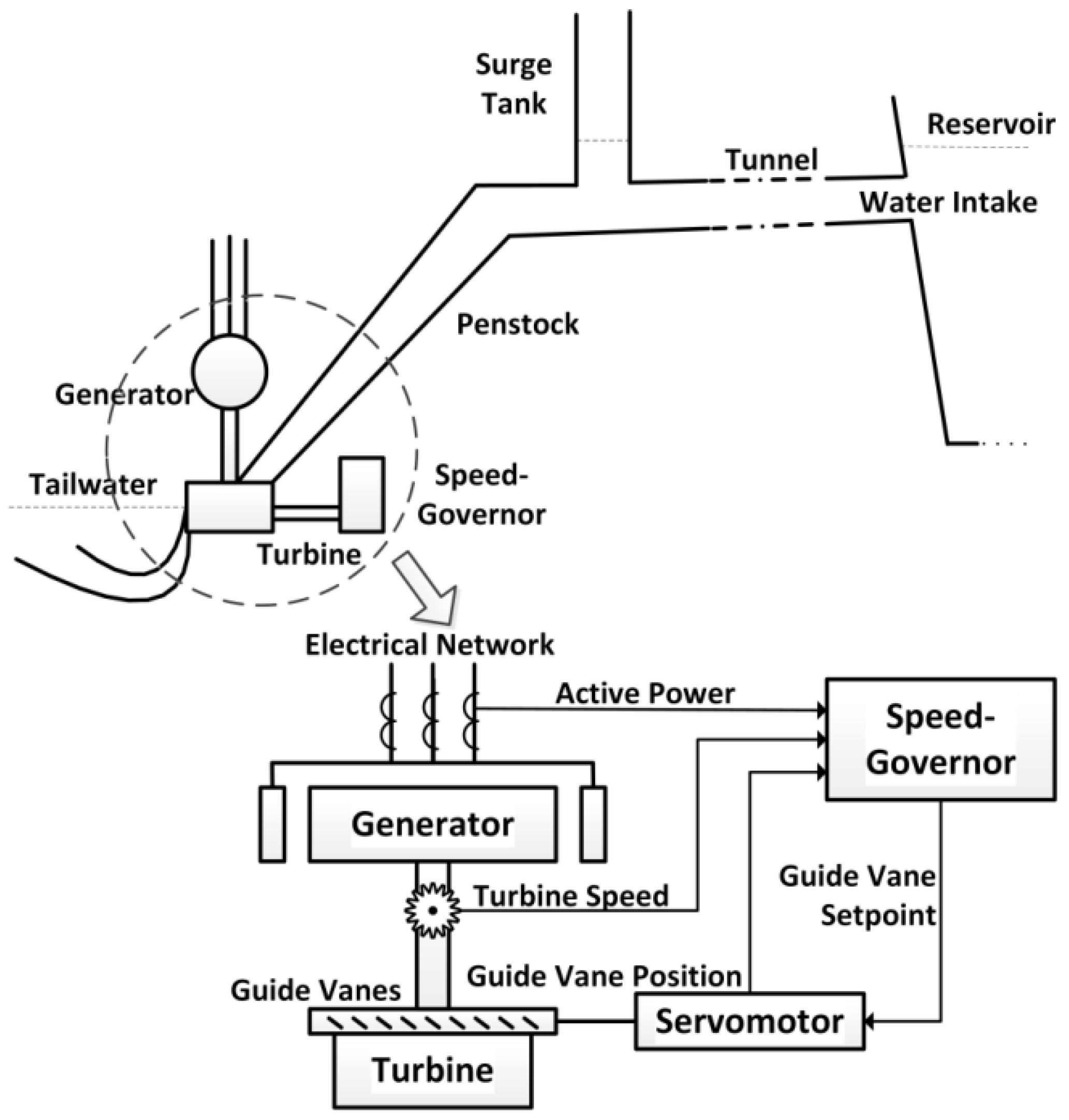
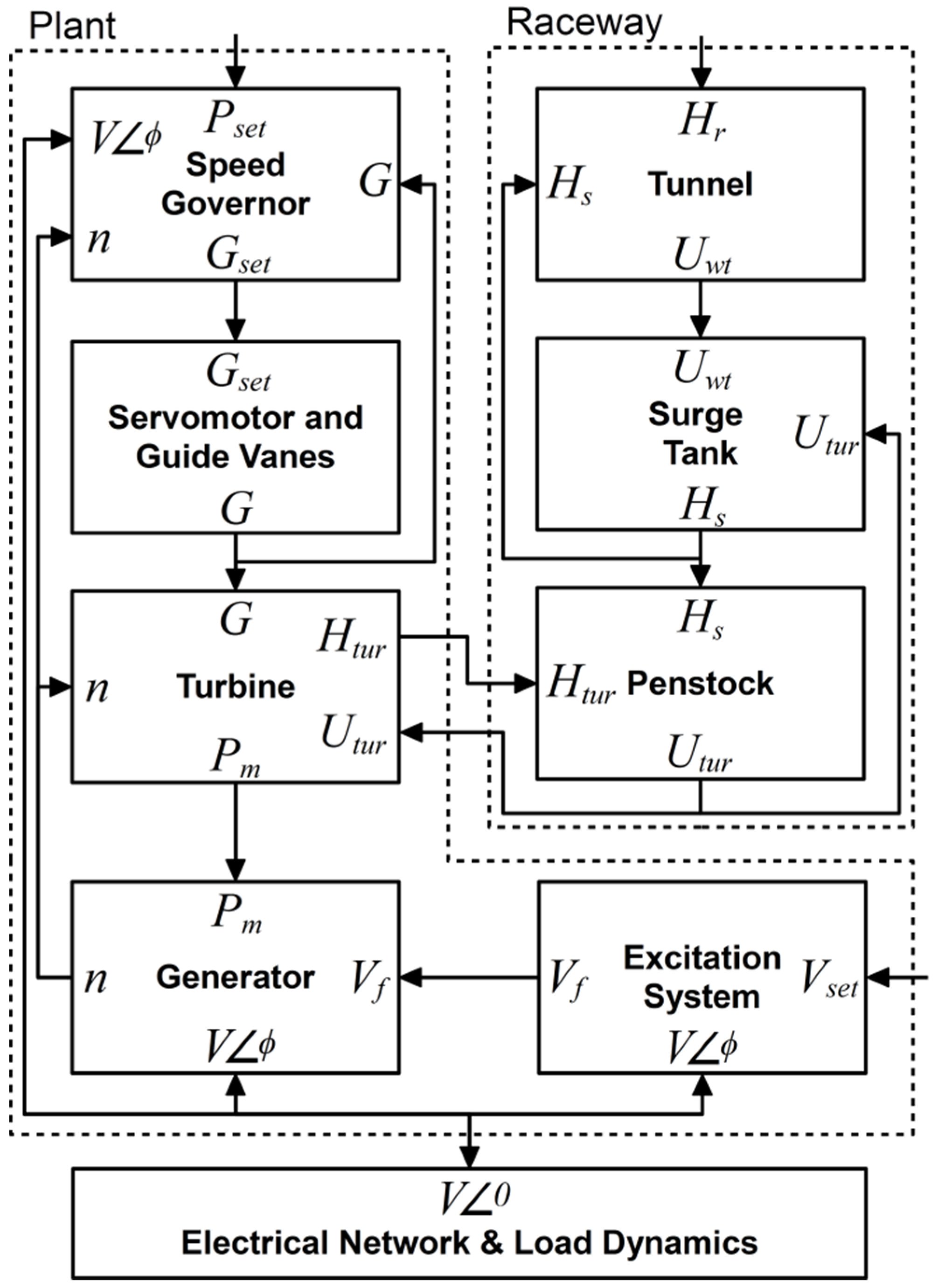

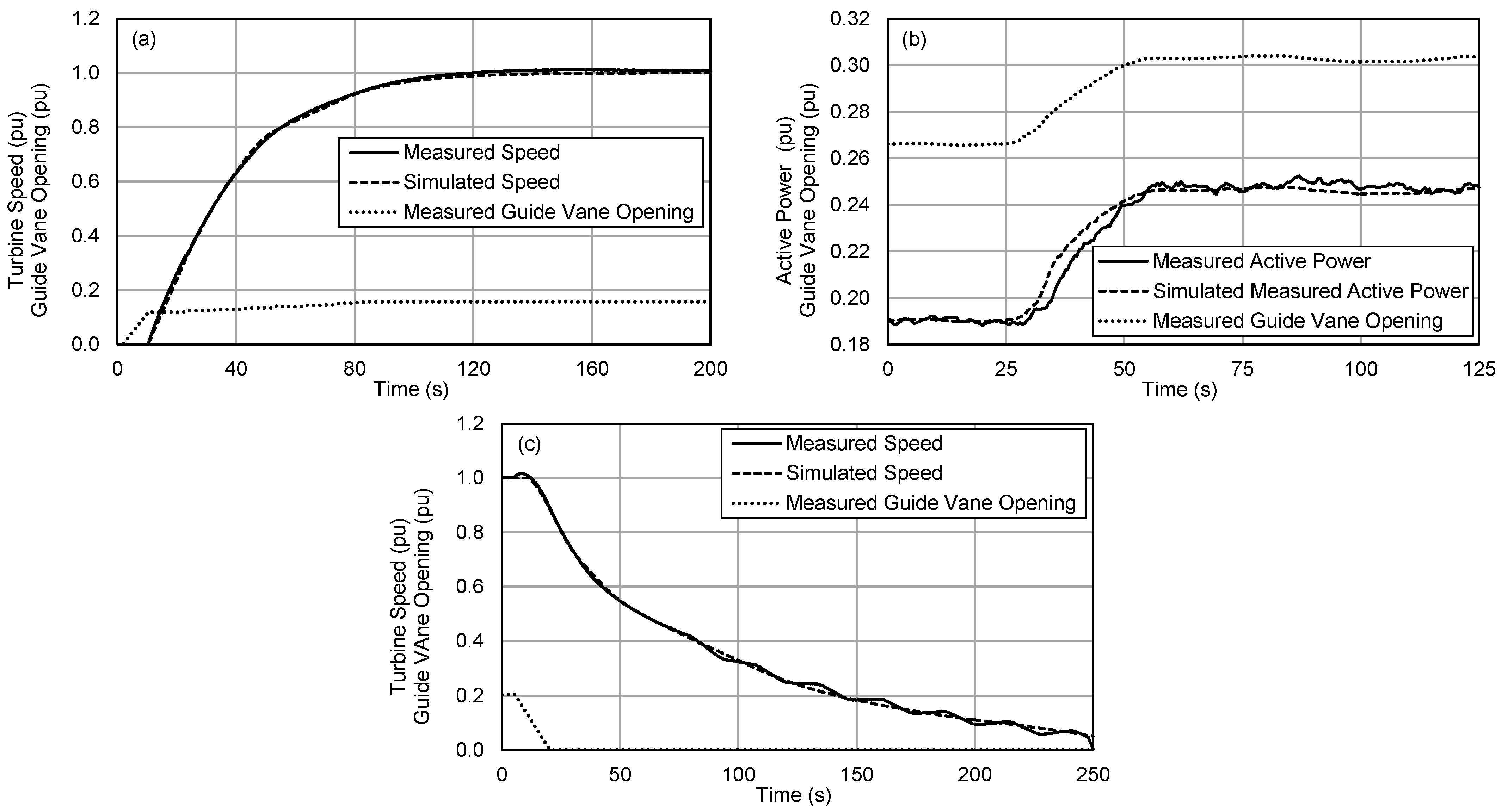
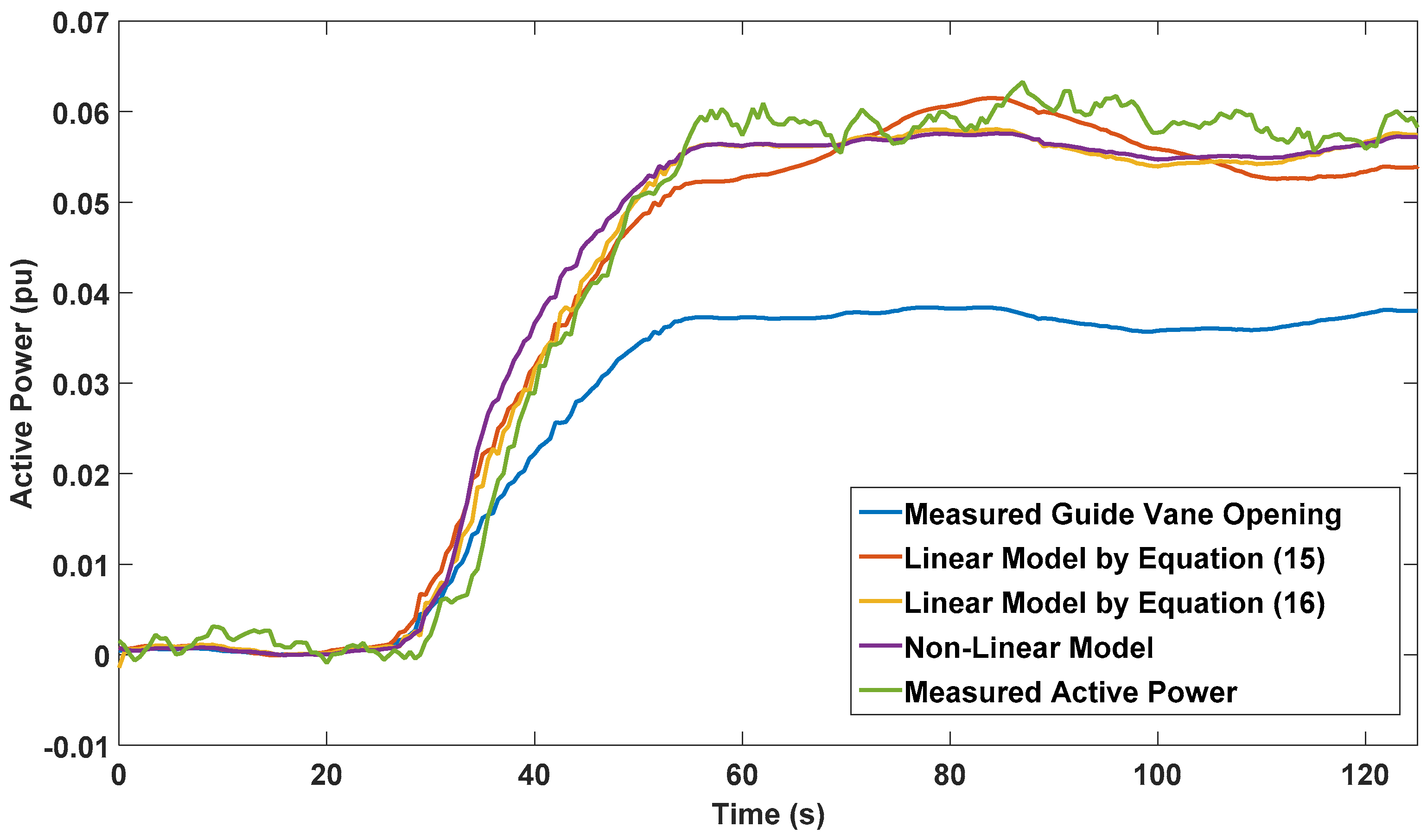


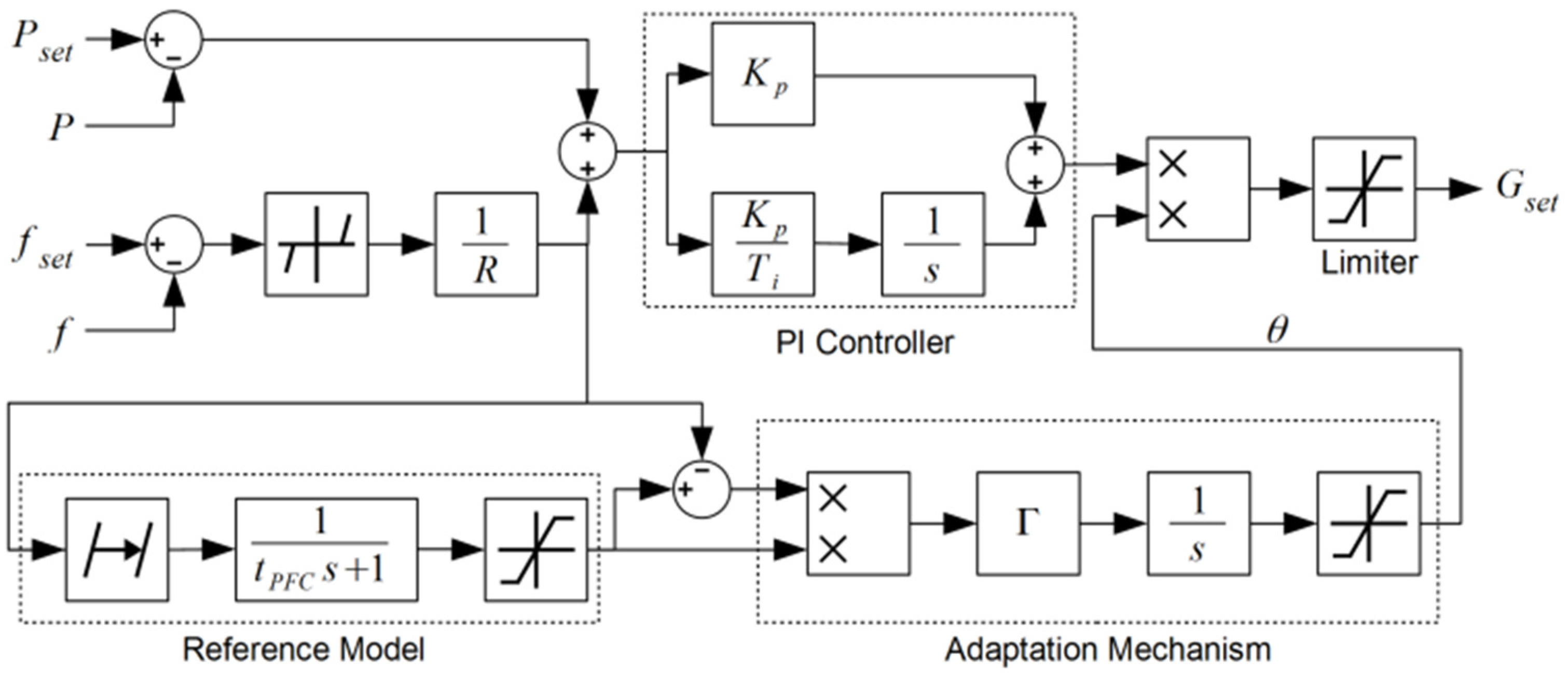
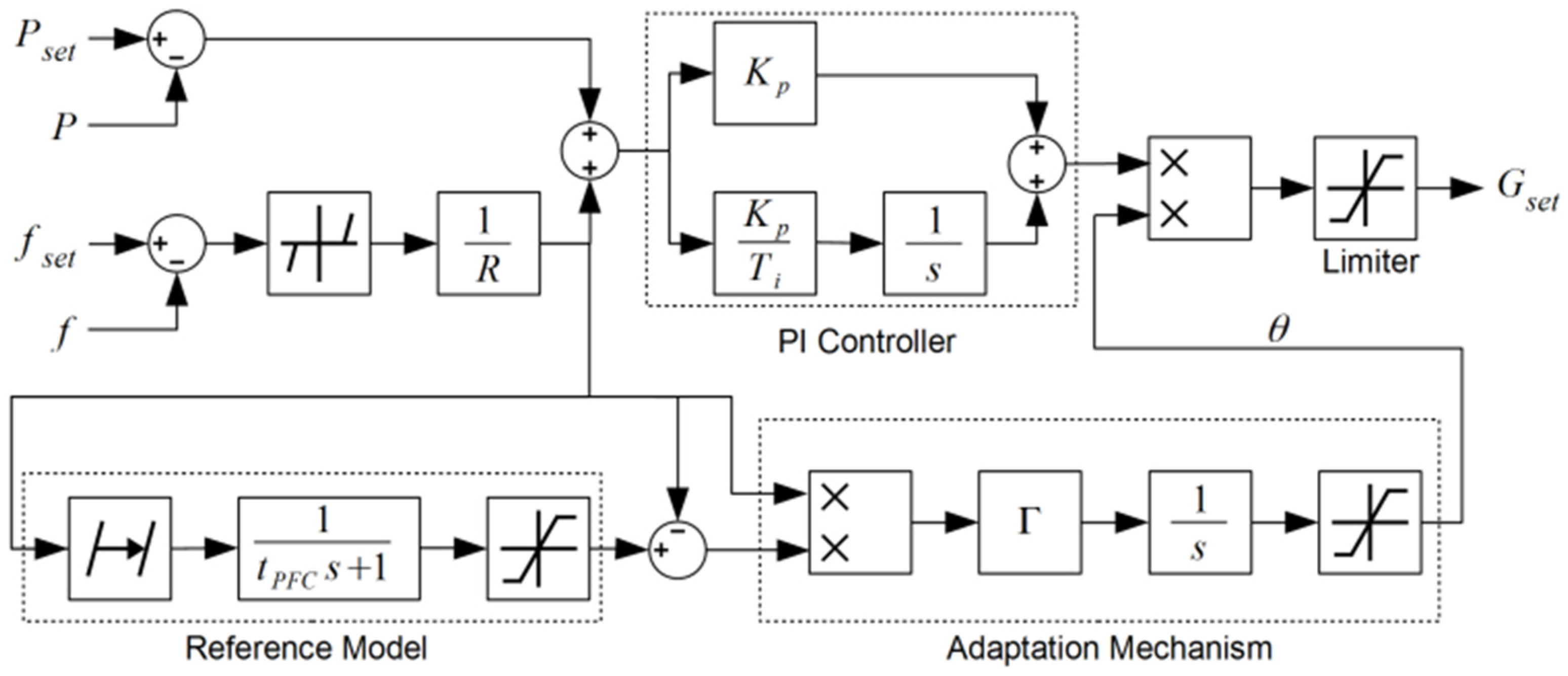

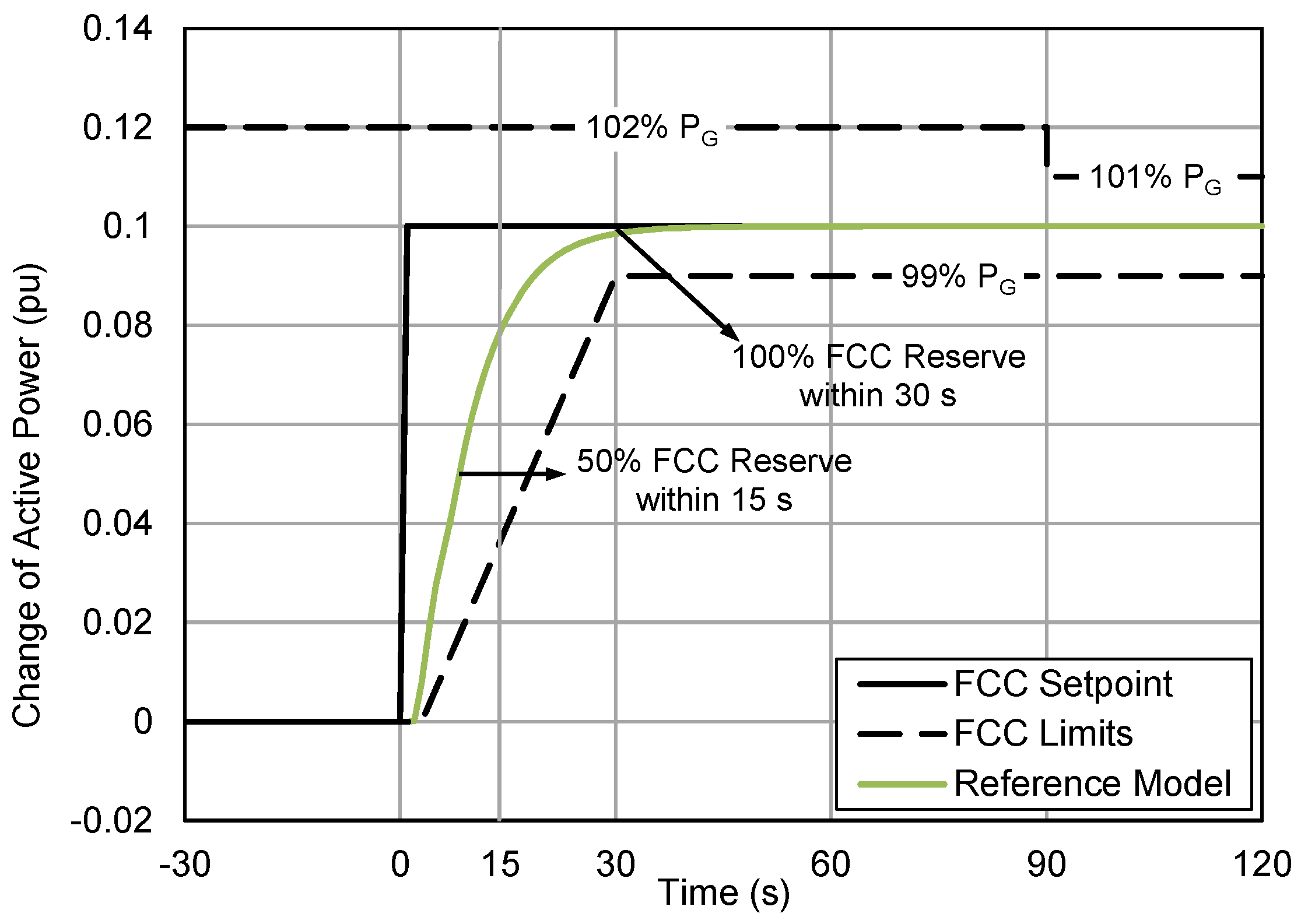



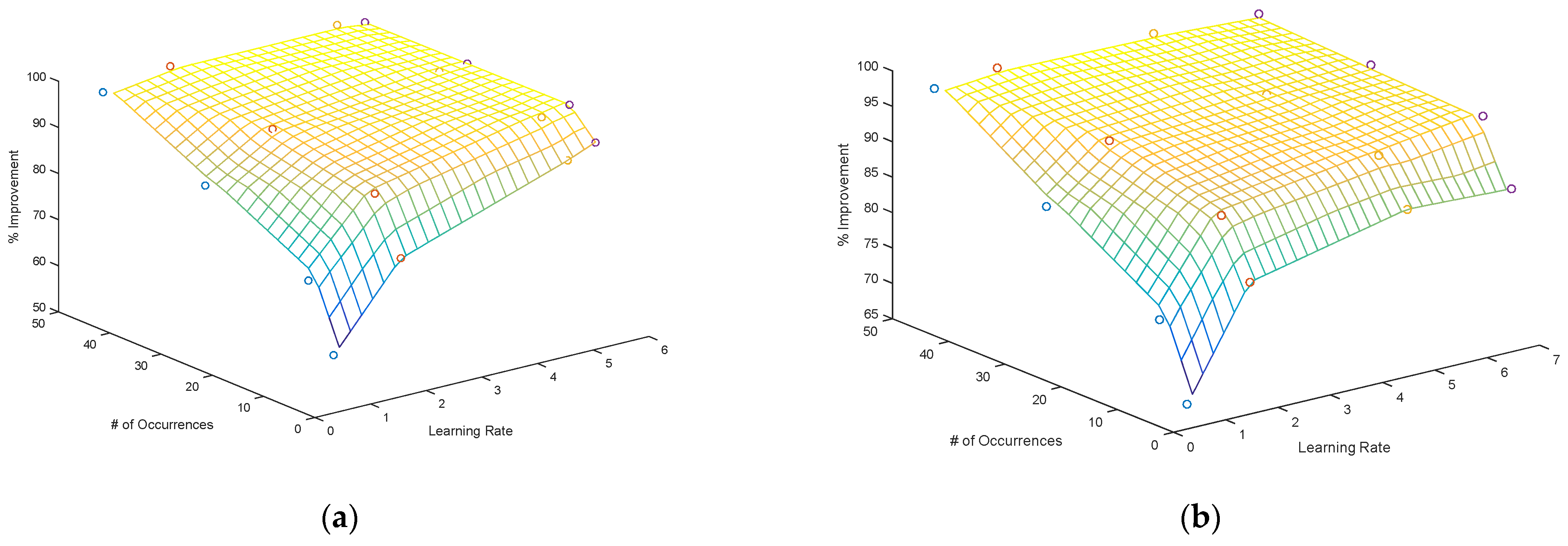
| Parameter | Value | Unit |
|---|---|---|
| Nominal net head | 32 | m |
| Nominal flow rate | 77 | m3/s |
| Surge tank storage capacity | 124.8 | s |
| Surge tank cross-sectional area | 380 | m2 |
| Penstock length | 81.7 | m |
| Penstock cross-sectional area | 21.2 | m2 |
| Penstock friction factor | 0.05 | - |
| Guide vane opening at no-load | 11 | % |
| Guide vane opening at full-load | 85 | % |
| Servomotor time constant | 4 | s |
| Guide vane delay time | 2 | s |
| Flywheel effect of the generator | 3320 | tone.m2 |
| Turbine nominal speed | 125 | rpm |
| Apparent power of the generator | 22.5 | MVA |
| Inertia constant of the generator | 3.14 | s |
| Case | Number of Cycles | Improvement wrt Baseline | ||
|---|---|---|---|---|
| Type | Γ | |||
| MIT rule | - | - | 1 pu | baseline |
| MIT rule | 0.8 | 5 | 0.412 pu | 58.8% |
| MIT rule | 0.8 | 10 | 0.272 pu | 72.8% |
| MIT rule | 0.8 | 50 | 0.047 pu | 95.3% |
| MIT rule | 2 | 5 | 0.237 pu | 76.3% |
| MIT rule | 2 | 10 | 0.118 pu | 88.2% |
| MIT rule | 2 | 50 | 0.026 pu | 97.4% |
| MIT rule | 5 | 5 | 0.112 pu | 88.8% |
| MIT rule | 5 | 10 | 0.041 pu | 95.9% |
| MIT rule | 5 | 50 | 0.025 pu | 97.5% |
| Lyapunov | 0.8 | 5 | 0.341 pu | 65.9% |
| Lyapunov | 0.8 | 10 | 0.237 pu | 76.3% |
| Lyapunov | 0.8 | 50 | 0.039 pu | 96.1% |
| Lyapunov | 2 | 5 | 0.189 pu | 81.1% |
| Lyapunov | 2 | 10 | 0.111 pu | 88.9% |
| Lyapunov | 2 | 50 | 0.031 pu | 96.9% |
| Lyapunov | 5 | 5 | 0.139 pu | 86.1% |
| Lyapunov | 5 | 10 | 0.079 pu | 92.1% |
| Lyapunov | 5 | 50 | 0.035 pu | 96.5% |
Publisher’s Note: MDPI stays neutral with regard to jurisdictional claims in published maps and institutional affiliations. |
© 2021 by the authors. Licensee MDPI, Basel, Switzerland. This article is an open access article distributed under the terms and conditions of the Creative Commons Attribution (CC BY) license (https://creativecommons.org/licenses/by/4.0/).
Share and Cite
Gezer, D.; Taşcıoğlu, Y.; Çelebioğlu, K. Frequency Containment Control of Hydropower Plants Using Different Adaptive Methods. Energies 2021, 14, 2082. https://doi.org/10.3390/en14082082
Gezer D, Taşcıoğlu Y, Çelebioğlu K. Frequency Containment Control of Hydropower Plants Using Different Adaptive Methods. Energies. 2021; 14(8):2082. https://doi.org/10.3390/en14082082
Chicago/Turabian StyleGezer, Doğan, Yiğit Taşcıoğlu, and Kutay Çelebioğlu. 2021. "Frequency Containment Control of Hydropower Plants Using Different Adaptive Methods" Energies 14, no. 8: 2082. https://doi.org/10.3390/en14082082
APA StyleGezer, D., Taşcıoğlu, Y., & Çelebioğlu, K. (2021). Frequency Containment Control of Hydropower Plants Using Different Adaptive Methods. Energies, 14(8), 2082. https://doi.org/10.3390/en14082082






